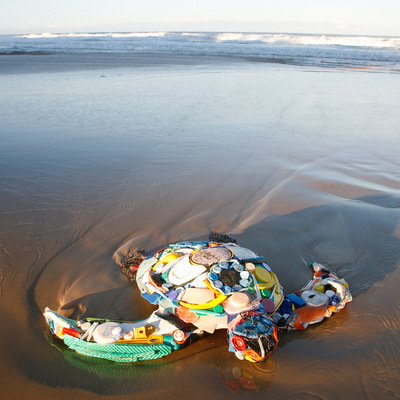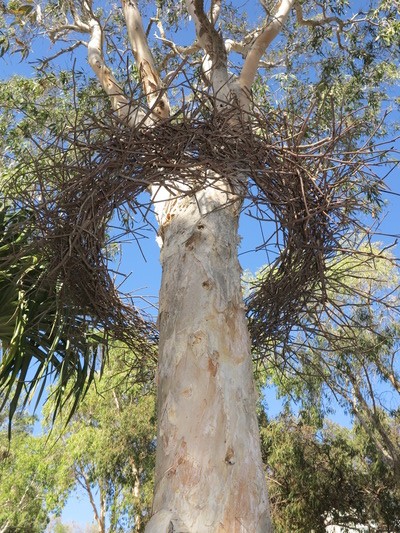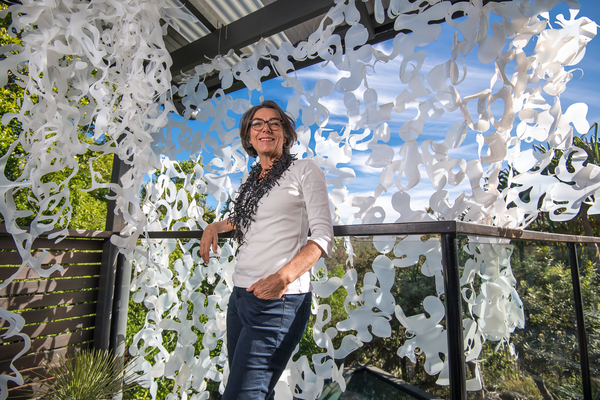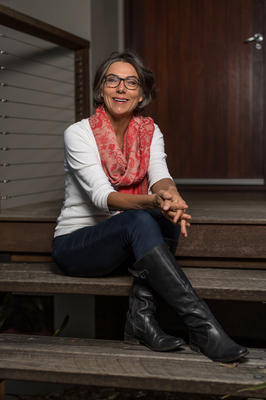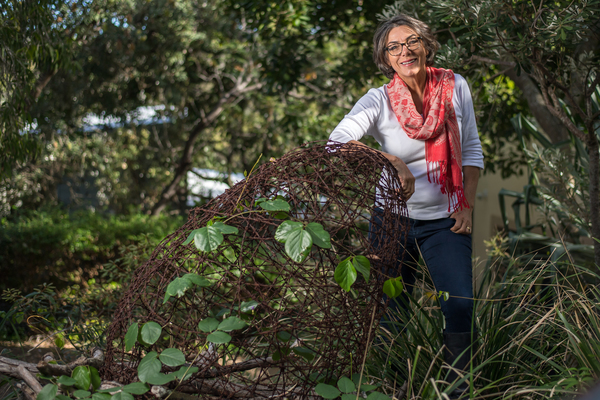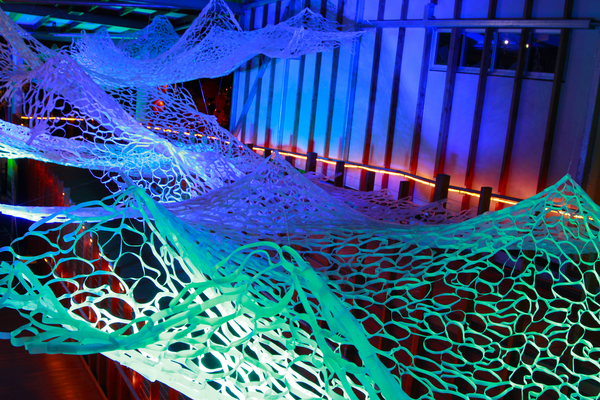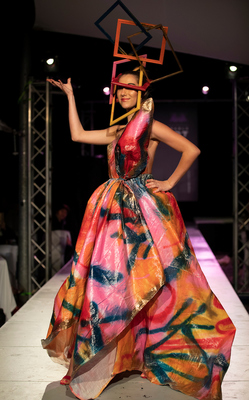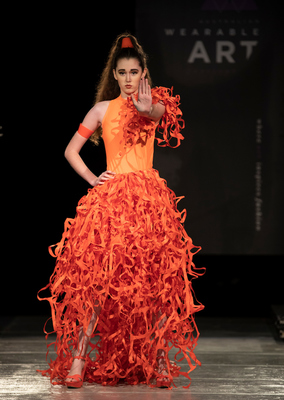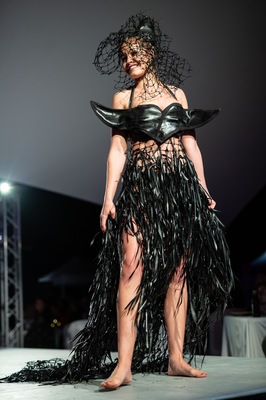Art can create conversation, generate joy and stimulate creative thinking, reflection and awareness.
And if necessary, art has the ability to inspire change.
Inspiring change is something long-time Sunshine Beach resident and artist Yanni Van Zijl hopes to do with her environmental art works.
“I believe art can inspire a grass roots movement, from the individual, to corporations, to government to create change,” Yanni said.
Yanni spends her days creating art in all forms from photography, ceramics, three-dimensional pieces, ephemeral work, sculptures and installation work.
Most recently, Yanni had three entries into the Australian Wearable Art Festival in Eumundi, pushing the boundaries of fashion into the realm of sculpture.
Yanni’s daughter Sophia modelled Yanni’s garments which were made from resourced or discarded materials.
“I enjoyed the challenge to make something beautiful from things that otherwise would have gone to landfill,” she said.
The first piece, called ‘Fashionista’ was made from Clean Up Australia and weed bags that Yanni uses each week when volunteering with bush regeneration.
“The woven texture reminded me of canvas, always having longed to paint I enjoyed the creative process of spray painting the bags prior to the garment construction. The head dress was made from old picture frames,” Yanni said.
The second garment, called ‘Great Australian Bight BLIGHT’ was made from bicycle inner tubes and an old tennis net which resembled fishing nets.
“My inspiration was that due to oil and gas exploration, deadly seismic blasting has recently been approved in the whale rich waters of the Great Australian Bight. These sonar cannons fire loud explosions every 10-15 seconds 24 hours a day seven days a week which have a deadly impact on zooplankton. It damages whales hearing and keeps them from feeding and breeding grounds,” she said.
Finally, the third garment called ‘High Viss-uals’ was made from discarded roadside barrier material.
“I hand cut formations into the existing plastic to create a lighter lacier design. The hair cuff and matching bracelet were made from a traffic cone,” Yanni said.
Being creative seems to have always been a major part of Yanni’s life, as a child you would find her outdoors playing with whatever she could find.
“I was a master mud cake maker, I guess things haven’t changed all that much, now I play with clay and making things from waste which brings great satisfaction,” she said.
“I had always wanted to study art but my parents thought it a waste of time, getting a paying job straight out of school was more important to them.”
Yanni was born in Melbourne and first moved to Queensland at the age of 13, before eventually moving to Sunshine Beach with her husband.
“Peter and I decided to move to Sunshine Beach 22 years ago despite warnings from people who lived here at the time saying, ‘don’t come as there isn’t any work.’ Thank heavens we didn’t take their advice,” she said.
Yanni certainly found work for herself doing something she loved, after studying a Diploma of Photography she became a self-employed photographer.
“It was terrific as it gave me the ability to be a stay at home mum. 13 years later I studied a diploma of Fine Art at Tewantin TAFE,” she said.
“I now pursue art full time but haven’t yet found my ‘one’ thing. I studied the diploma of art as I have always longed to paint, photography is painting with light, but it was getting my hands dirty that I enjoyed most, hence ceramics, 3D and ephemeral work. I explore form and dream of building huge sculptures. Often my ceramics are maquettes for these ideas.
“I also love installation work, several years ago I met Pam Walpole and we started to collaborate under art forARTsake as we felt there was a lack of art locally. We make installations that bring about awareness to environmental issues. We began making large installations from HDPE – recycled milk bottle plastic, we use it to highlight the issues of recycling and plastic in the ocean.”
Plastic and other marine debris is a globally recognised environmental issue of increasing concern.
CSIRO conducts world-leading research into marine debris in Australia and beyond, on land and at sea, to help protect ecosystems and wildlife.
A recent study by CSIRO surveyed rubbish at 100km intervals around the Australian coastline and found three-quarters of it was plastic, as was most floating debris. The study found the density of plastic ranges from a few thousand pieces of plastic per square kilometre to more than 40,000 pieces of plastic per square kilometre. Globally about one third of marine turtles and nearly half of seabird species have likely ingested debris, the study found. CSIRO predicts plastic ingestion by seabirds may reach 95 per cent by 2050.
In 2017 a consortium of 47 environment groups nationwide chose Noosa as the pilot area in Queensland to test plastic-free living through a campaign by environmental group the Boomerang Alliance.
The latest figures released by Plastic Free Noosa revealed that at the end of March the amount of plastic saved is 2.7 million pieces. That’s the number of pieces of plastic that would have been used by businesses and organisations had they not decided to switch away from plastic.
Yanni hopes to inspire more people to take the plastic-free initiative with her art installations.
“We have one planet, it nurtures and provides for us, and we need to nurture it in return if we expect it to continue to do so,” she said.
“You cannot repeatedly take without giving something back.
“I applaud Noosa Today having gone plastic free, it is one thing to talk about plastic, however actions speak louder than words, that is what Noosa Today has done.”
Change often starts with the youth, and Yanni is working on an initiative called eARTh-ed to engage kids with creative sustainability workshops, with the help of environmental educator Kylie Moses: art 4 eARTh.
“With eARTh-ed education I tell the kids that they have the power to make change, imagine if every child refused a straw, would fast food chains still provide them? They have a voice and a responsibility,” she said.
Being surrounded by nature is what Yanni loves most about Noosa and the hinterland.
“We are extremely fortunate to back onto the Noosa National Park, having the bush at the back door and the beach in walking distance makes me grateful each and every day. What we noticed when we first moved here was how friendly everyone was, I put it down to the fact that we all feel so lucky to live here,” she said.
Yanni is currently working on a range of projects, starting off with an entry for Sculpture on the Edge (SOTE) in Maleny which will be a living sculpture.
“I created the forms and am currently coaxing moss to grow onto them. It is a work about the health of forests and how we need to nurture and protect the smaller components if we desire optimum health for a forest, same applies for the ocean, micro plastics are as damaging as big pieces of plastic. We need to take care at a micro level then the bigger issues will follow,” she said.
Under art forARTsake Pam and Yanni are working on a site-specific installation for Floating Land in October.
“It’s very exciting, this is the first year there will be work in situ in the Noosa National Park. Art in the landscape, a perfect combination for me,” she said.
The artistic pair have also been accepted into SWELL on the Gold Coast, where they are making a 15-metre installation made from milk bottles.
And it doesn’t stop there, Yanni is also taking part in Noosa Open Studios, where she will be displaying her ceramics and sculptures on Friday 16 August.
“Noosa Open Studios is another fantastic initiative showcasing the brilliant local talent we have here in spades,” Yanni said.
To check out more of Yanni’s artworks visit www.facebook.com/YanniPhotographerAndArtist/ and don’t forget to keep an eye out for the art installations by Yanni and Pam by visiting ‘Art forARTsake Noosa’ on Facebook.

